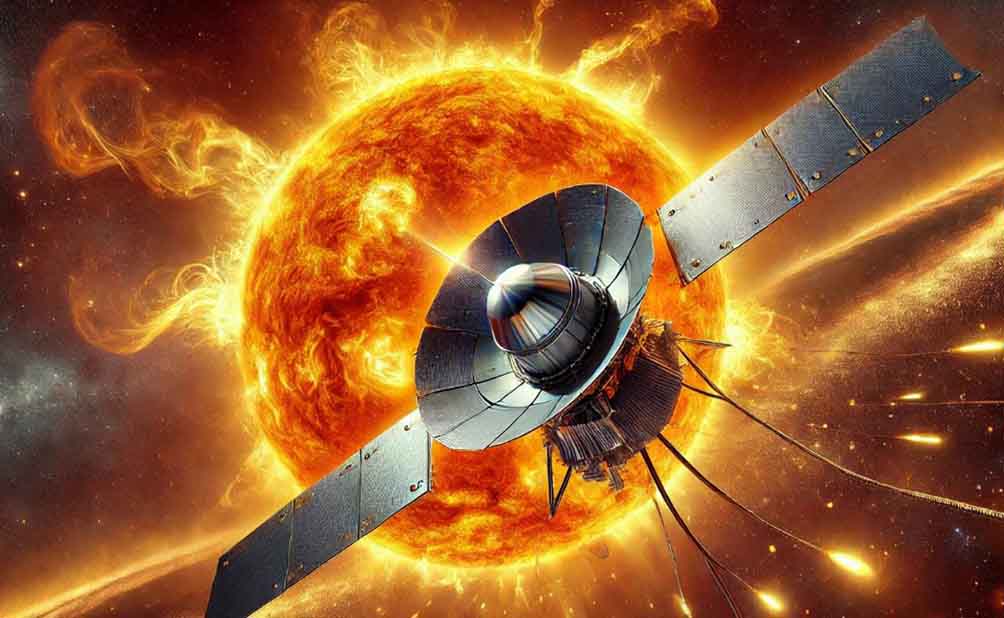Introduction
NASA’s Parker Solar Probe has ventured closer to the Sun than any spacecraft in history, completing an unprecedented solar flyby. Scientists eagerly await a critical signal from the probe, confirming its survival and return of invaluable data. As humanity pushes the boundaries of solar exploration, this milestone presents thrilling possibilities and high stakes.
The Parker Solar Probe’s journey is a triumph of engineering, aiming to unlock secrets about our closest star. But will the mission’s daring success include a safe return signal? Let’s dive into the details of this groundbreaking mission.
What Makes the Parker Solar Probe Mission Historic?
The Parker Solar Probe, launched by NASA in August 2018, is the first spacecraft designed to “touch the Sun.” Equipped with advanced heat-resistant technology, the probe has now completed its closest flyby—plunging into the Sun’s corona at a record-breaking distance of approximately 3.9 million miles from the solar surface.
Key Mission Highlights:
- Speed: Traveling at an astounding 430,000 miles per hour, it’s the fastest human-made object ever.
- Temperature Resilience: Withstands temperatures up to 2,500°F (1,377°C) using its cutting-edge Thermal Protection System (TPS).
- Scientific Goals: To study the Sun’s magnetic fields, solar wind, and coronal heating processes.
According to NASA, these findings will provide critical insights into solar phenomena affecting Earth’s space weather and satellite systems.
The Agitation: Why Does This Signal Matter?
Despite its robust design, the Parker Solar Probe operates in an environment more extreme than anything humanity has previously attempted. This daring mission comes with risks, including potential damage to its systems due to intense solar radiation.
Waiting for a signal—NASA’s equivalent of a spacecraft “phone home”—is a nail-biting experience for scientists. A successful transmission would confirm that:
- The probe survived its closest encounter.
- It has collected the expected high-value data.
Failure to receive this signal could mean the loss of years of work and billions of dollars in investment.
Challenges Encountered
1. Heat and Radiation
The Sun’s outer atmosphere, or corona, is a hotbed of charged particles and intense electromagnetic activity. The TPS acts as a shield, but prolonged exposure poses risks.
2. Communication Delays
Given the probe’s immense distance from Earth, signals take minutes to reach NASA’s Deep Space Network. Precise timing is essential for data retrieval.
3. Solar Storms
Unpredictable solar flares and coronal mass ejections could potentially disrupt communication or damage the spacecraft.
How the Parker Solar Probe Overcomes Obstacles
NASA engineers have implemented multiple safeguards to protect the spacecraft:
- Autonomous Navigation: The probe can adjust its trajectory without human input to avoid damage.
- Revolutionary Materials: Carbon-composite shielding ensures durability under extreme heat.
- Data Storage: In case of delayed transmissions, data is stored for later relay.
A report by Scientific American highlights that the success of this mission will serve as a benchmark for future solar explorations.
What Comes Next?
If the Parker Solar Probe successfully transmits its signal, scientists will analyze:
- Solar Wind Data: To understand how charged particles accelerate.
- Magnetic Field Observations: To study the Sun’s chaotic magnetic activities.
- Coronal Heating Insights: Why the Sun’s outer layer is hotter than its surface—a long-standing mystery.
The findings could revolutionize our understanding of the Sun and its impact on Earth.
Key Takeaways
- The Parker Solar Probe represents a monumental leap in space exploration.
- Surviving its historic close encounter with the Sun depends on advanced technology and years of preparation.
- Data collected could reshape solar science, benefiting everything from satellite technology to climate research.
FAQs
1. What is the Parker Solar Probe?
The Parker Solar Probe is NASA’s spacecraft designed to study the Sun’s outer atmosphere.
2. Why is this mission significant?
It marks the closest approach to the Sun in history, aiming to answer fundamental questions about solar activity.
3. What data is the probe collecting?
It studies solar wind, magnetic fields, and coronal heating processes.
4. When will we know if the probe survives?
NASA anticipates receiving the signal within a specific post-flyby timeframe, subject to communication delays.
5. How does this mission benefit Earth?
Understanding the Sun’s behavior can improve satellite safety, GPS accuracy, and power grid protection from solar storms.
Table: Parker Solar Probe vs. Previous Solar Missions
| Feature | Parker Solar Probe | Previous Missions |
| Closest Distance | ~3.9 million miles | ~27 million miles (Helios) |
| Speed | 430,000 mph | ~150,000 mph (Helios) |
| Temperature Resistance | 2,500°F | ~1,000°F (Older Probes) |
Conclusion
NASA’s Parker Solar Probe continues to defy expectations, pushing the limits of technology and science. As we await confirmation of its success, the mission underscores humanity’s relentless curiosity and ingenuity.
Stay tuned for updates as NASA unveils the secrets of the Sun, paving the way for a brighter scientific future.
sources:
- NASA’s Parker Solar Probe ‘Safe’ After Closest-Ever Approach to Sun
- NASA’s Parker Solar Probe Makes Closest-Ever Flyby to the Sun
- NASA Confirms Success of Parker Solar Probe in Record Approach to the Sun
- Scientists Await Signal from NASA’s Parker Solar Probe After Historic Close Sun Flyby
- NASA Probe Successfully Completes Closest-Ever Approach to Sun
- NASA’s Parker Probe Phones Home After ‘Touching Sun’ in Historic Flyby
- NASA’s Parker Solar Probe Satellite Makes Closest-Ever Approach to Sun
- NASA Spacecraft Makes History with Closest Encounter with the Sun
- Parker Solar Probe Attempts Closest-Ever Approach to the Sun
- Parker Solar Probe – NASA Blogs
- NASA’s Parker Solar Probe Makes Historic Christmas Eve Flight
- Parker Solar Probe – Wikipedia

